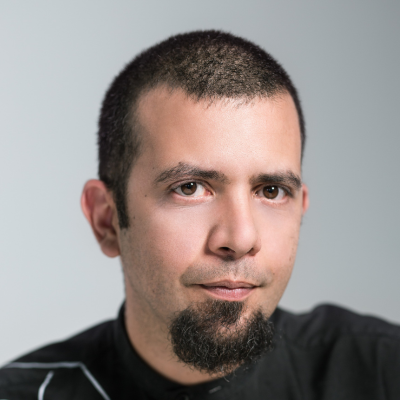João Catalão
Guest Professor in Percussion and Director of the UdeM Percussion Workshop

- Tell us about your journey in a few words.
After starting classical violin at the age of 7 and later exploring drumming in a hardcore band, my passion eventually centered on contemporary music and its percussion. This path led me to study with great masters such as percussionist Ney Rosauro in Brazil, then Emmanuel Séjourné in France, and Robert Leroux in Montreal. Throughout these experiences, popular music has always remained an important part of my career, notably through my participation in various Brazilian jazz bands. In addition to teaching at the Faculty of Music, I currently co-lead in Montreal the collective Thuya, dedicated to improvised music of all kinds, in collaboration with guitarist and composer Sylvain Pohu. Furthermore, as a member of the Sixtrum percussion ensemble, an artist-in-residence at the Faculty of Music, and the Ensemble Obiora, I find fulfillment as a percussionist and composer by exploring three distinct musical domains: contemporary music, jazz, and classical symphonic music.
- Tell us about your field of research.
I am particularly interested in how theatrical approaches and acting techniques can be applied to music. This focus led me to earn a doctorate in performance at the University of Montreal. Inspired by acting techniques developed by Stanislavski, Grotowski, and Eugenio Barba, I initiated a similar approach for the work of musical performers. My goal was not necessarily to add a theatrical role to the performance but to create a pathway toward organic interpretation. This involves connecting the performer’s inner world with the piece to maintain the freshness of the initial experience, even after repeatedly playing the same repertoire.
- What led you to play your instrument?
My journey toward percussion was sparked by an epiphany during my first class with percussionist Ney Rosauro. After this lesson at the Brasilia Summer Festival, I abandoned my hardcore drummer look, shaving my head deeply that night, and became the musician I am today. My path is closely tied to contemporary art in its various forms and expressions. My experience with the theater department of the University of Santa Maria in Brazil also introduced me to another dimension of being a performing artist. This multidisciplinary influence has left a significant mark on my practice.
- How would you describe your teaching style?
I believe that the learning process is unique to each student. I can guide them, show them different paths, but I am aware that it is up to them to make the connections. Since every individual is unique, I consider it essential to be attentive to this uniqueness to support them in their journey as artists.
- How does research or research-creation influence your teaching methods?
When I realized that my own questions as a performer also resonated with my students’ experiences, a feedback loop developed between my creative process as a musician and composer and my teaching approach. Working with students of various levels and ages gave me a new perspective on my role as a performer. This opened up new approaches for my research. Likewise, immersing myself more deeply in the musical field through coherent and reflective research allowed me to discover new ways of teaching music, beyond those taught during my own training. This approach enables me to adapt to each student’s unique reality.
- What qualities do you think are most important for a percussionist?
First and foremost, you must be a musician. Listening skills and familiarity with multiple styles are of utmost importance. Ear training is also essential. We need to conceptualize music in our minds before expressing it in other ways.
- Who are your favorite artists, music groups, or albums?
This is the hardest question! There are so many! I’d mention Hermeto Pascoal, a living musical genius; John Cage, for his perpetual questioning; Iannis Xenakis, for breaking paradigms; and Heitor Villa-Lobos, for expressing his cultural universe through a universal musical language.
- A memorable professional encounter?
The impact of Ney Rosauro is etched in my memory due to the profound musical revelation that shaped my career. However, I cannot forget other important figures such as Jan Williams, a percussionist who worked alongside eminent musicians like John Cage and George Crumb. Additionally, Joel Chadabe, a composer and researcher in electroacoustic music, played a crucial role. They opened the doors to a new realm in contemporary music, bringing a fresh perspective to modern musical creation.
- Tell us about a concert, exhibition, or conference that influenced your career.
The Latin American Meeting in Santa Maria in 1995 was a turning point in my journey. There, I had the privilege of meeting iconic figures in contemporary percussion, such as Leigh Howard Stevens, Siegfried Fink, John Beck, John Hollenbeck, and many others. This experience allowed me to explore, for the first time, the range of styles and aesthetics within my instrument family.
- Besides music, name another of your passions.
Astronomy and history are my other passions. Yes, I know, it’s a bit "geeky," but these fields fuel my imagination and creative universe!
Spring 2024